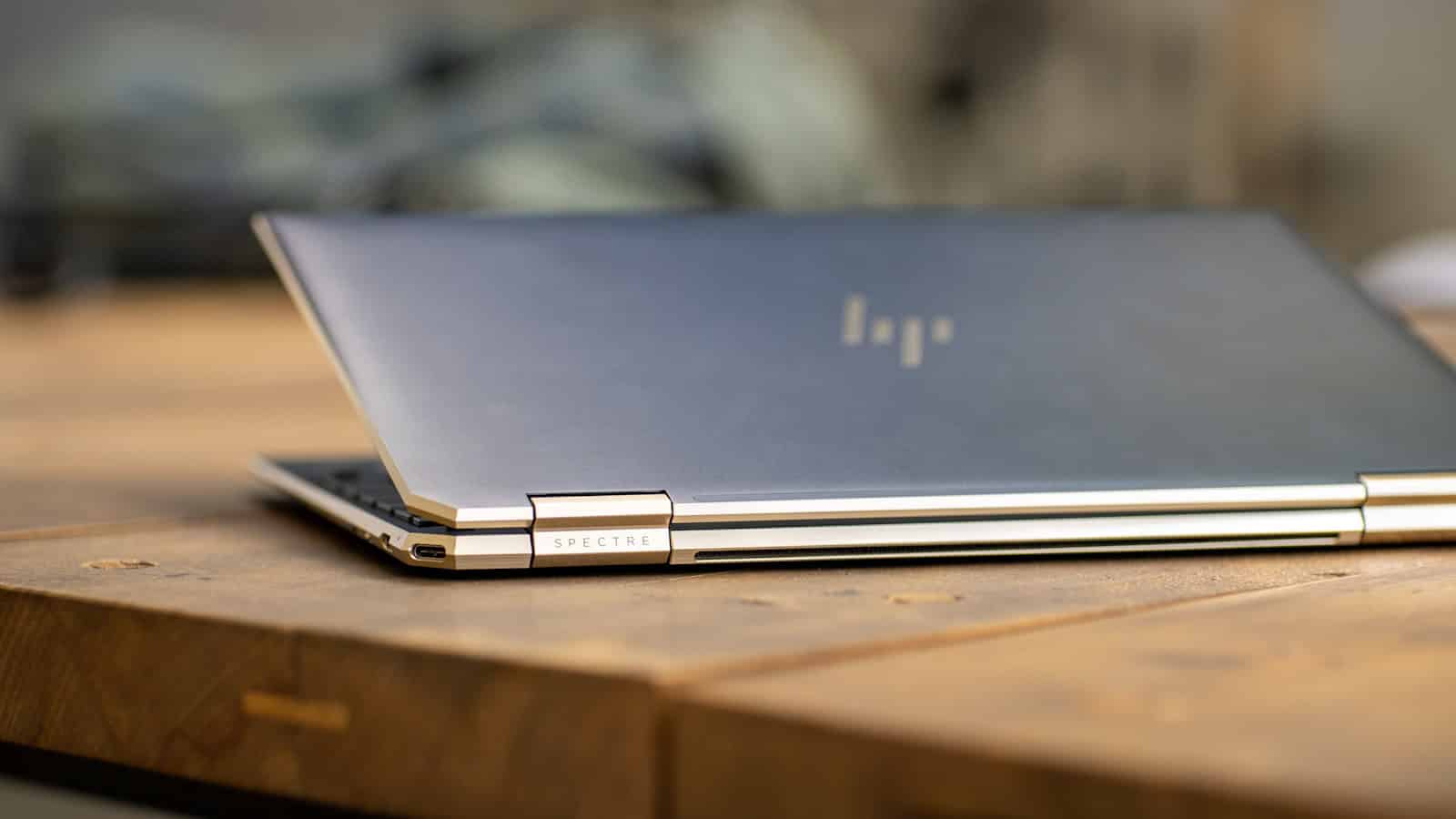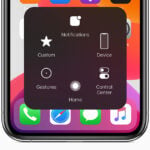Replacing parts on an HP laptop involves a careful process that varies depending on the specific model and the component you’re replacing. Here’s a general step-by-step guide to help you with most HP laptops:
General Steps to Replace Parts on an HP Laptop
1. Backup Your Data
Before doing anything, back up your files. There’s always a risk of damaging internal components during a hardware replacement.
2. Power Down and Unplug
- Shut down the laptop completely.
- Disconnect the charger and any peripherals (USB devices, SD cards, etc.).

3. Remove the Battery (If Possible)
- On older HP laptops, slide the battery release latch and remove the battery.
- On newer models, the battery may be internal—you’ll have to open the back panel.
4. Open the Back Panel
- Use a precision screwdriver to remove all visible screws from the bottom panel.
- Some screws may be hidden under rubber feet or stickers.
- Carefully pry open the panel using a plastic spudger or guitar pick to avoid scratching or cracking the casing.
Common Parts and How to Replace Them
🔋 Battery (Internal)
- Locate the battery (usually a flat black pack).
- Unscrew it if needed and disconnect the battery cable from the motherboard.
- Replace with a compatible battery and reconnect the cable.
💾 Hard Drive / SSD
- Find the storage drive (usually 2.5″ SATA or M.2 SSD).
- Unscrew any brackets holding it in place.
- Gently slide it out (SATA) or unscrew the M.2 SSD and remove it at an angle.
- Replace with the new drive and secure it.
🧠 RAM (Memory)
- Locate the RAM slot(s), often under a separate flap.
- Push the metal clips on either side outward; the stick will pop up.
- Remove and insert new RAM at a 30-degree angle, then push it down to click into place.
🌬️ Fan or Cooling Assembly
- Disconnect the fan cable.
- Unscrew and remove the fan and heatsink.
- Clean off old thermal paste and apply new paste if you’re removing the heatsink.
- Reattach and screw everything down firmly.
💡 Keyboard, Display, or Motherboard
These require advanced disassembly:
- Disconnect ribbon cables carefully.
- Follow a service manual or teardown video for your specific model (search “HP [model number] disassembly” on YouTube or iFixit).
- Keep screws organized and label them if needed.
🧷 Reassemble and Test
- Reattach all internal components and cables.
- Reinstall the back panel and screws.
- Reconnect the battery if it was disconnected.
- Power on the laptop and verify the new component is recognized and working.
Tips
- Model-specific Service Manuals: Available on HP’s support site.
- Use Antistatic Precautions: Ground yourself or use an anti-static wristband.
- Work on a clean, flat surface with good lighting.
Laptops Buying Guide
Laptops have become essential tools for work, education, and entertainment. These portable computers offer the power of a desktop in a compact, foldable design that fits in a backpack or briefcase. Modern laptops come in various forms, from traditional clamshell designs to 2-in-1 convertibles that double as tablets when needed.
The laptop market offers options for every user, whether you need a basic machine for web browsing and document editing or a high-performance system for gaming and video editing. Prices range from budget-friendly models under $300 to premium devices costing thousands of dollars. The right choice depends on your specific needs and how you plan to use your laptop.
When shopping for a laptop, you should focus on four key factors: performance (processor, RAM, storage), display quality, battery life, and portability. These elements directly impact your daily experience with the device. The keyboard feel and port selection also matter, especially if you’ll use your laptop for long typing sessions or need to connect various peripherals. Finding the right balance of these features within your budget will lead to a satisfying purchase.
Performance is the foundation of any good laptop. The processor (CPU) serves as the brain of your computer. Intel and AMD make most laptop CPUs, with options ranging from basic chips for everyday tasks to powerful processors for demanding applications. For most users, an Intel Core i5 or AMD Ryzen 5 provides enough power for common tasks.
RAM (memory) determines how many programs your laptop can run simultaneously. 8GB is now the practical minimum, while 16GB offers more breathing room for future needs. Heavy multitaskers or those using memory-intensive applications should consider 16GB or more. Storage has evolved from mechanical hard drives to faster solid-state drives (SSDs), which boot up quicker and load programs faster.
Display quality affects everything you do on your laptop. Screen size typically ranges from 13 to 17 inches, with 14 and 15-inch models being most common. Larger screens show more content but result in heavier, less portable laptops. Resolution matters too – 1920×1080 (Full HD) is standard, while higher resolutions like QHD or 4K offer sharper images but consume more battery.
Battery life can make or break your laptop experience. The best laptops now offer 8-12 hours of real-world use between charges. Your usage patterns will determine how important this feature is. If you frequently work away from power outlets, prioritize models with strong battery performance. Manufacturers’ claims often exceed real-world results, so check independent reviews for accurate battery life assessments.
Portability involves both weight and dimensions. Ultrabooks and thin-and-light laptops prioritize slim designs and lightweight materials, often weighing under 3 pounds. These models sacrifice some performance and features to achieve maximum portability. Standard laptops typically weigh 3-5 pounds, while gaming laptops and workstations can exceed 5 pounds due to their powerful components and cooling systems.
Keyboard quality varies widely between laptop models. Look for comfortable key travel, good spacing, and solid feedback. A backlit keyboard helps when typing in dim environments. The touchpad should track accurately and support multi-touch gestures. Some business laptops include pointing sticks as an alternative navigation method.
Connectivity options determine what you can plug into your laptop. USB ports remain essential, with newer USB-C/Thunderbolt ports offering faster data transfer and video output capabilities. HDMI ports allow connection to external monitors or TVs. An SD card reader helps photographers and videographers transfer files. Consider what peripherals you’ll use regularly before choosing a laptop.
Best Laptops
Our selection of top laptops for 2025 includes options for every need and budget. These machines offer the latest processors, impressive battery life, and sleek designs that will serve you well for years to come. Whether you need a powerful workstation for creative projects or a lightweight device for everyday tasks, you’ll find the perfect match in our carefully researched recommendations.
Jumper EZbook S7-Hi Laptop
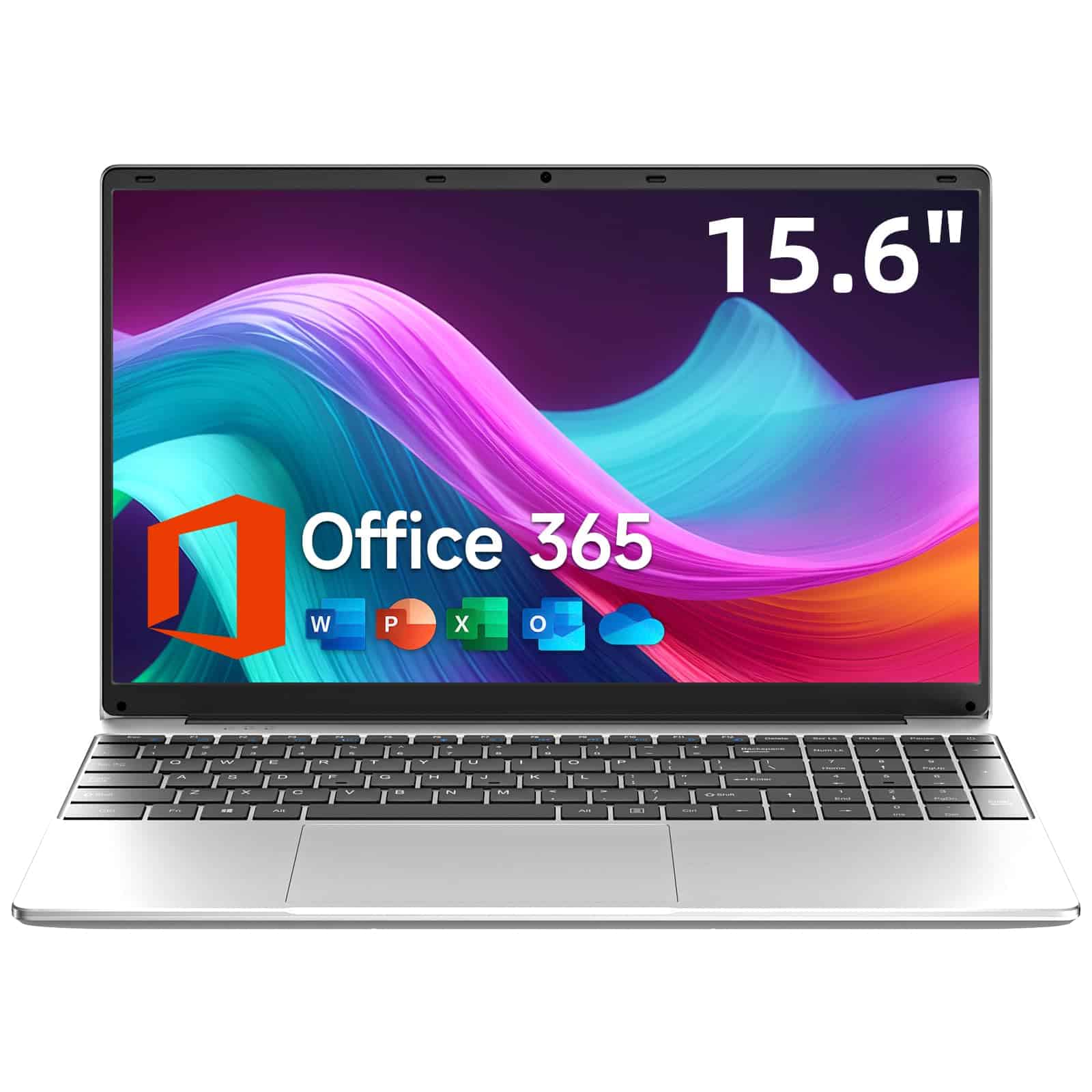
This budget-friendly laptop offers excellent value for students and casual users with its portable design and included Office 365 subscription.
Pros
- Lightweight at 3.6 lbs with a slim profile
- Includes one-year Office 365 subscription
- Expandable storage up to 1TB
Cons
- Limited 4GB RAM may struggle with multitasking
- Basic 1366×768 display resolution
- Entry-level Celeron processor
The Jumper EZbook S7-Hi strikes a good balance between affordability and functionality. At just 3.6 pounds, you can easily slip this 15.6-inch laptop into your bag for school or work. The Intel Celeron 5205U processor (1.9GHz) handles basic tasks like document editing, web browsing, and video streaming without issue.
Storage options make this laptop particularly versatile for its price range. While the base 128GB SSD isn’t enormous, the additional expansion slot supporting up to 1TB gives you plenty of room to grow. This flexibility proves useful when your file collection inevitably expands over time.
Connectivity won’t be an issue with this machine. Multiple ports including Type-C, HDMI, and an SD card reader ensure you can connect to various peripherals and displays. The pre-installed Windows 11 paired with the included one-year Office 365 subscription means you’re ready to work right out of the box – a significant value addition that saves you money upfront.
Battery life is sufficient for a day of light use, though you’ll want to keep the charger handy for longer sessions. The 15.6-inch display, while not Full HD, provides adequate clarity for document work and casual media consumption. For students or business users with basic computing needs who prioritize portability and value, this Jumper laptop represents a solid choice.
Lenovo IdeaPad 1 Student Laptop
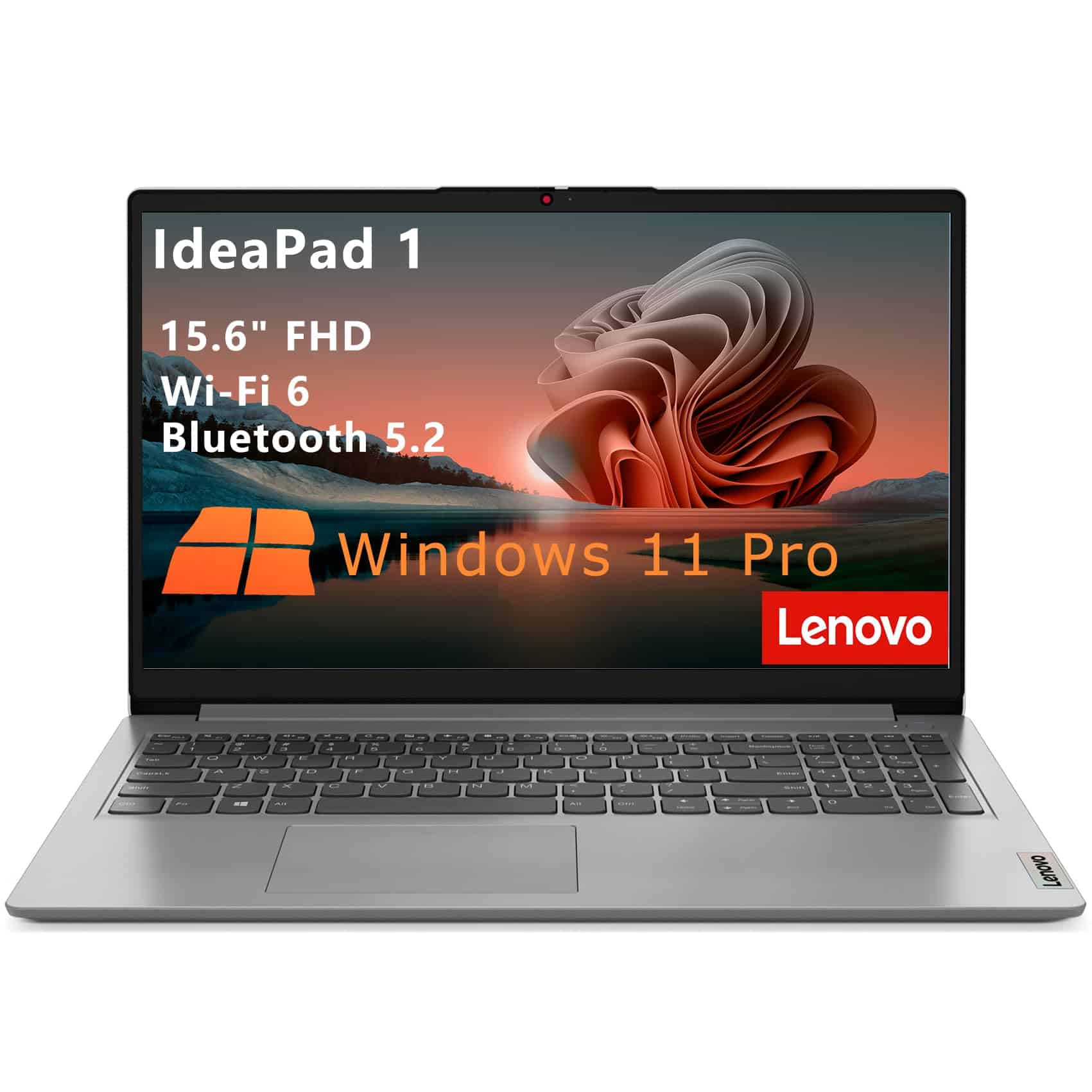
This budget-friendly Lenovo laptop offers exceptional memory and storage for students and casual users despite its entry-level processor.
Pros
- Generous 32GB RAM and 1TB SSD storage
- Lightweight design at just 3.42 pounds
- Windows 11 Pro provides advanced features
Cons
- Intel Celeron processor limits performance for demanding tasks
- Non-backlit keyboard hampers low-light usage
- Limited port selection compared to higher-end models
The Lenovo IdeaPad 1 balances affordability with surprising specs in specific areas. You’ll appreciate the substantial 32GB of RAM that handles multitasking with ease, while the spacious 1TB SSD provides ample storage for documents, photos, and videos without the sluggishness of traditional hard drives.
Display quality doesn’t disappoint with a 15.6-inch Full HD anti-glare screen that reduces eye strain during long study sessions. The laptop’s cloud grey chassis maintains a professional appearance while remaining lightweight at approximately 3.42 pounds, making it highly portable for carrying between classes or work meetings.
Battery life extends to reasonable levels with the integrated 42Wh battery, though intensive tasks will drain it faster. Connectivity options include WiFi 6 and Bluetooth 5.2 for modern wireless performance, while the HD webcam with privacy shutter adds a thoughtful security feature. The Intel Celeron N4500 processor represents the main compromise, handling basic tasks adequately but struggling with more demanding applications like video editing or gaming.
For students, remote workers, or anyone needing a budget laptop primarily for web browsing, document creation, and basic productivity, this IdeaPad delivers exceptional value. The inclusion of Windows 11 Pro rather than Home edition adds professional features typically reserved for more expensive models.
Naclud 15.6″ Laptop
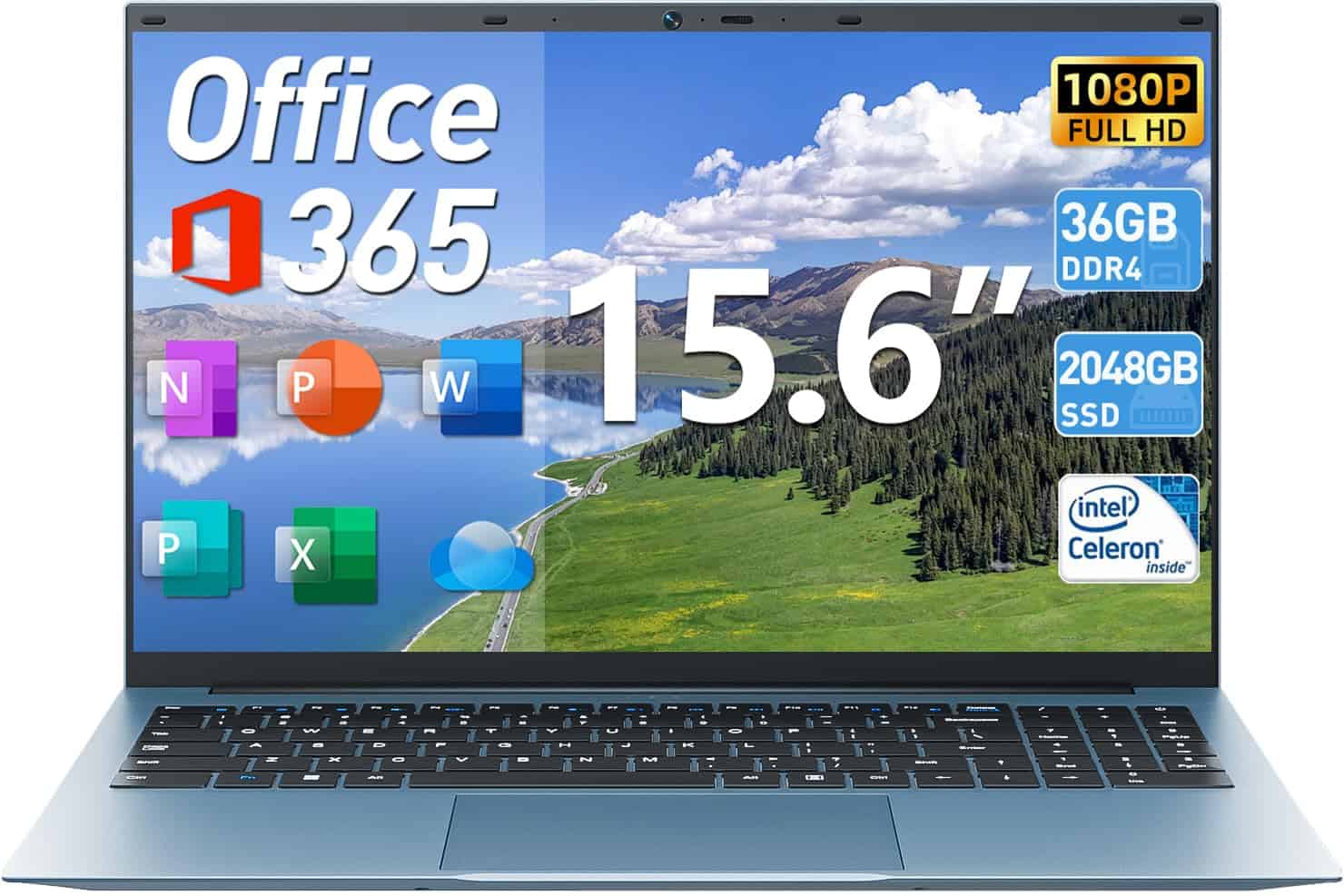
The Naclud 15.6″ laptop offers exceptional value with its impressive specs, ample storage options, and full HD display that make it ideal for both work and entertainment needs.
Pros
- Generous 36GB RAM and 2048GB SSD storage capacity
- Full HD 1920×1080 display with 180° viewing angle
- Comprehensive connectivity with USB 3.2, HDMI, and Type-C ports
Cons
- Intel Celeron processor may struggle with demanding applications
- Weighs 5.14 pounds, slightly heavier than some competitors
- Limited customer reviews as a newer product
This sleek gray laptop combines performance and versatility with its Celeron N5095 quad-core processor and substantial 36GB RAM. You’ll appreciate how smoothly it handles multitasking between applications, particularly for everyday productivity tasks like document editing, web browsing, and video conferencing.
Storage concerns become a thing of the past with this machine. The combination of 128GB eMMC and an additional 2048GB SSD provides ample space for your files, applications, and media library. Your data transfers will move quickly thanks to the USB 3.2 ports and modern connectivity options including WiFi 6 and Bluetooth 5.2.
Battery life won’t disappoint with the 7000mAh capacity that keeps you working throughout the day. The 15.6-inch display delivers crisp visuals with its full HD resolution, making it suitable for both work documents and entertainment. Windows 11 Home comes pre-installed, and the laptop includes a 1-year Microsoft 365 subscription that gives you immediate access to essential productivity tools.
Connectivity options abound with this Naclud model. Three USB 3.2 ports, HDMI output, RJ45 Ethernet, and a Type-C port that handles charging and external displays give you flexibility for all your peripheral needs. Released in January 2025, this laptop represents one of Naclud’s latest offerings in the portable computing market.
HP 14″ Student Laptop

The HP 14″ laptop offers decent performance for students and casual users with its upgraded RAM, though its limited storage and basic processor make it best suited for light computing tasks.
Pros
- 16GB DDR4 RAM allows smooth multitasking
- Compact 14″ design with multiple connectivity options
- Includes 1-year Office 365 subscription
Cons
- Limited 64GB eMMC storage requires cloud solutions
- Basic Intel Celeron processor isn’t ideal for demanding tasks
- Lower resolution display (1366 x 768) isn’t full HD
This silver HP laptop balances affordability with adequate performance for everyday tasks. The 16GB RAM configuration stands out as a highlight, allowing you to run multiple applications simultaneously without frustrating slowdowns. Students will appreciate how easily you can switch between research tabs, document editing, and communication apps.
Storage might become an issue over time with only 64GB of eMMC capacity. You’ll likely need to rely on cloud storage solutions or external drives for document management. The Intel Celeron N4120 processor handles basic computing needs but may struggle with resource-intensive applications or advanced multitasking.
Connectivity is comprehensive with USB-C, traditional USB ports, HDMI, and even an Ethernet port for wired internet. Battery life is sufficient for classroom use. The 14″ HD display offers acceptable quality for document work and web browsing, though the 1366 x 768 resolution won’t impress those used to sharper screens. For students needing a reliable computer for notes, assignments and online research, this HP laptop delivers essential functionality at a reasonable price point.
HP 14 Laptop
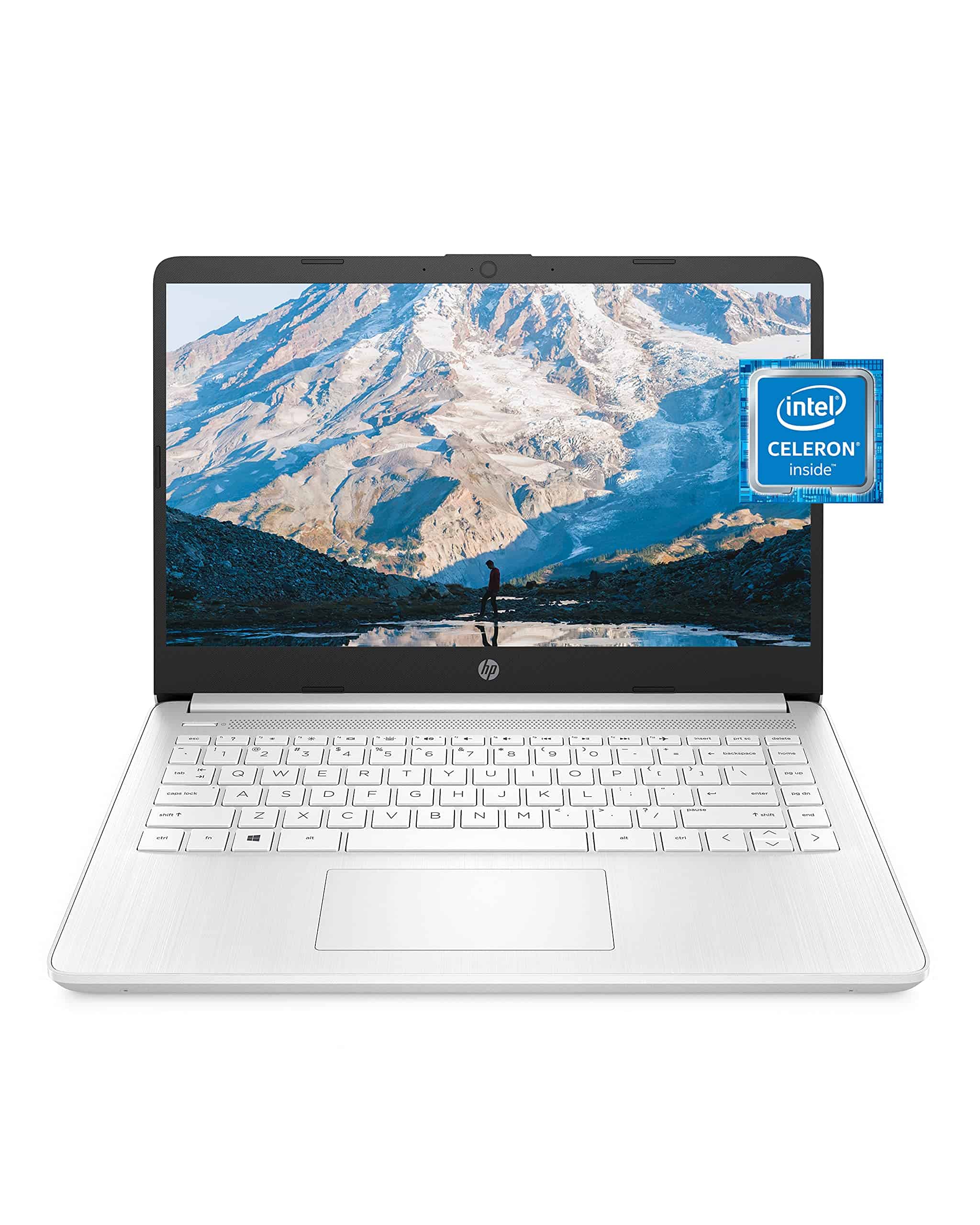
This budget-friendly HP laptop offers good value for basic computing needs despite its limited storage and processing power.
Pros
- Lightweight, portable design with micro-edge display
- Long battery life (up to 11.5 hours)
- Includes one-year Microsoft 365 subscription
Cons
- Limited 64GB storage capacity
- Basic Intel Celeron processor performance
- Windows 11 S mode restricts app installations
The HP 14 strikes a balance between affordability and functionality for everyday tasks. Its slim profile and micro-edge display maximize screen space while keeping the overall footprint compact enough for easy transport. The 14-inch HD display provides adequate clarity for web browsing, document editing, and video streaming, though the 1366 x 768 resolution won’t impress those seeking premium visuals.
Performance comes from an Intel Celeron N4020 processor paired with 4GB RAM – sufficient for basic productivity and web browsing but not ideal for demanding applications or multitasking. This laptop works best for students, casual users, or as a secondary device. The Intel UHD Graphics 600 can handle basic visual tasks and streaming but isn’t suitable for serious gaming or professional design work.
Battery life stands out as a major advantage, with up to 11.5 hours of runtime and fast charging capabilities. Storage might be the biggest limitation with only 64GB of eMMC capacity, which fills quickly after system updates and basic applications. The included one-year Microsoft 365 subscription adds value with cloud storage and access to essential productivity apps. Windows 11 in S mode provides security benefits but limits you to Microsoft Store apps unless you switch out of this mode.
HP Pavilion 15.6″ Touchscreen Laptop

This HP Pavilion offers solid performance for everyday computing with its touchscreen capability and ample storage, making it a good choice for students and casual users.
Pros
- Generous 16GB RAM and 1TB SSD storage
- Touchscreen functionality adds versatility
- Good battery life (up to 11 hours)
Cons
- Lower resolution display (1366 x 768)
- Entry-level Intel Core i3 processor
- Some durability concerns noted in reviews
The HP Pavilion combines practical features at a reasonable price point. Its 15.6-inch HD touchscreen display lets you interact directly with your content, which proves helpful for note-taking or casual browsing. The anti-glare coating reduces eye strain during extended use sessions.
Under the hood, you’ll find 16GB of RAM that handles multitasking with ease. Opening multiple browser tabs, working on documents, and streaming content simultaneously won’t slow this machine down. The 1TB SSD provides ample space for your files while delivering quick boot times and snappy performance.
Connectivity options cover most needs with USB-C, two USB-A ports, and HDMI output. The Intel Core i3 processor (with turbo boost up to 4.1GHz) handles everyday tasks adequately but may struggle with more demanding applications like video editing or gaming. Windows 11 Home comes pre-installed, giving you access to the latest Microsoft features.
The silver chassis looks professional and resists fingerprints well. At 3.74 pounds, it’s relatively portable for a 15.6-inch laptop. Battery life extends to about 11 hours with moderate use, letting you work through most of the day without hunting for an outlet.
For students, remote workers, or casual users who need reliable performance without breaking the bank, this HP Pavilion represents a solid value. Just be aware that the HD display resolution (not Full HD) might disappoint if you frequently watch high-definition content or need precision for design work.
Dell Inspiron 15 Touchscreen Laptop

You should consider this Dell Inspiron for its impressive balance of performance features and business functionality at a reasonable price point.
Pros
- Generous 32GB RAM and 1TB SSD storage
- Full HD touchscreen with IPS display
- Windows 11 Pro pre-installed
Cons
- Average battery performance
- Integrated graphics limiting for serious gaming
- Webcam quality is just basic at 720p
The Dell Inspiron 15 combines productivity and portability in a sleek carbon black design. With an Intel Quad-Core i5-1155G7 processor capable of reaching 4.5GHz boost speeds, you’ll experience quick responses when multitasking between applications. The 32GB RAM configuration ensures smooth operation even with numerous browser tabs and programs running simultaneously.
Touchscreen capability adds a convenient dimension to your computing experience. The 15.6-inch Full HD IPS display delivers vibrant colors and wide viewing angles, making it suitable for both work presentations and casual media consumption. Navigation becomes intuitive when you can interact directly with on-screen elements.
Connectivity options abound with this business-oriented laptop. You’ll find two USB 3.2 ports for faster data transfers, an additional USB 2.0 port, and an HDMI connection for external monitors. The built-in SD card reader proves handy for photographers and content creators. Windows 11 Pro provides enhanced security features and management capabilities that home editions lack.
Physical design elements enhance daily usability. The numeric keypad benefits those who regularly work with spreadsheets or financial applications. At 3.65 pounds and measuring just 0.69 inches thick, transporting this laptop between meetings or classes won’t strain your shoulders or take up excessive space in your bag.
For business users and students needing reliable performance without breaking the bank, this Dell offers significant value. While not designed for intensive gaming or video editing due to its integrated graphics, it handles everyday productivity tasks, video conferencing, and streaming with ease.
Acer Aspire 3

This budget-friendly Acer laptop offers solid performance for everyday tasks with its Ryzen processor, making it ideal for students and casual users seeking reliability without breaking the bank.
Pros
- Lightweight design perfect for on-the-go use
- Crisp 15.6″ Full HD IPS display with narrow bezels
- Improved thermal system for longer, more efficient work sessions
Cons
- Limited 128GB storage may fill quickly
- No backlit keyboard
- Windows 11 S mode restrictions require workaround
The Acer Aspire 3 strikes a balance between affordability and functionality that makes it attractive for students and casual users. Its AMD Ryzen 3 7320U processor paired with 8GB of LPDDR5 memory delivers smooth performance for everyday tasks like web browsing, document editing, and media consumption. The laptop feels surprisingly capable despite its budget-friendly price point.
Display quality stands out immediately when you open the lid. The 15.6-inch Full HD IPS panel produces vivid colors and sharp details that make everything from spreadsheets to streaming videos look great. Narrow bezels maximize your viewing area and give the laptop a more premium appearance than its price would suggest.
Connectivity options are plentiful with this Aspire model. You’ll find USB-C with DisplayPort support, two USB 3.2 ports, and HDMI 2.1 output—enough to connect all your essential peripherals. The improved thermal system with a 78% larger fan surface area helps maintain performance during longer work sessions, which proves especially helpful when you’re working away from a power outlet. Wi-Fi 6 support ensures fast, stable internet connections even in crowded networks.
Storage presents the most obvious limitation. The 128GB NVMe SSD, while speedy, fills up quickly once you install basic applications and save a few documents. You’ll likely need to invest in external storage or cloud services if you work with large files or have a substantial media collection. The Windows 11 S mode restriction, while security-focused, limits you to Microsoft Store apps until you switch out of this mode.
Battery life extends to about 11 hours of typical use, making it possible to get through a full day of classes or work without hunting for an outlet. The HD webcam with noise reduction technology handles video calls competently, which proves increasingly important for remote learning and work situations.
HP 17.3″ FHD Ryzen 5 Laptop

This spacious HP laptop offers excellent value with its large screen, ample memory, and solid performance for everyday computing needs.
Pros
- Generous 32GB RAM and 1TB SSD provide plenty of speed and storage
- Large 17.3″ FHD display ideal for multitasking and media consumption
- Six-core Ryzen 5 processor handles daily tasks with ease
Cons
- Weighs 4.6 pounds, making it less portable than smaller laptops
- Battery life limited to 9 hours, which may not last a full workday
- S mode requires extra steps to switch to regular Windows 11
The HP 17.3″ laptop stands out in the mid-range market with its impressive balance of screen real estate and performance. You’ll appreciate the full HD IPS display that delivers crisp visuals with anti-glare properties. This makes it perfect for long work sessions or enjoying movies without eye strain.
Under the hood, the AMD Ryzen 5 processor with six cores provides reliable performance for everyday computing tasks. Paired with 32GB of RAM, you can easily run multiple applications simultaneously without slowdowns. The 1TB SSD offers quick boot times and ample storage space for your documents, photos, and videos.
Connectivity options are plentiful with this machine. You get USB-C, two USB-A ports, HDMI, and a headphone jack. The built-in webcam includes a privacy shutter for peace of mind when not in use. A full-size keyboard with numeric keypad makes data entry more efficient. Wi-Fi 6 compatibility ensures you’ll have fast and stable internet connections when available.
ASUS E410 Laptop

The ASUS E410 offers good value for basic computing needs with a portable design and decent battery life despite its limited processing power and storage.
Pros
- Lightweight and portable design
- Good battery life for daily tasks
- Budget-friendly price point
Cons
- Limited 64GB storage capacity
- Basic Intel Celeron processor performance
- Low-resolution display (1366 x 768)
This 14-inch ASUS laptop balances affordability with essential functionality. The Intel Celeron N4020 processor paired with 4GB RAM handles basic tasks like web browsing, document editing, and media streaming. You’ll appreciate the slim profile that makes it easy to slip into a backpack or carry between rooms.
Battery life extends to approximately 10 hours, giving you plenty of time away from power outlets. The compact build doesn’t compromise on connectivity options either. With HDMI output, USB ports, and a card reader, you can connect to external displays and transfer files without hassle.
Storage might pose challenges for some users. The 64GB eMMC storage fills up quickly, especially after Windows updates. Consider investing in cloud storage solutions or external drives if you need to store numerous files. For students or casual users who mainly work online, this laptop provides essential functionality without breaking the bank.
Buying Guide
When shopping for a new laptop, prioritize your needs first. Consider what tasks you’ll perform most often – office work, gaming, video editing, or casual browsing.
Performance Considerations
The processor (CPU) is your laptop’s brain. For basic tasks, an Intel Core i3 or AMD Ryzen 3 works well. Power users should look at i7/i9 or Ryzen 7/9 processors.
RAM determines multitasking ability. 8GB is the minimum for most users today, while 16GB provides better future-proofing. Creative professionals may need 32GB or more.
Storage type matters more than size. SSDs offer faster performance than traditional hard drives (HDDs). Look for NVMe SSDs for the best speed.
Display Quality
Screen resolution affects clarity. Full HD (1920×1080) is standard, while 4K displays offer stunning detail but drain battery faster.
Consider display type too. IPS panels provide better viewing angles and color accuracy than TN panels.
Touch screens add convenience but increase price and reduce battery life.
Battery Life & Portability
Battery specifications can be misleading. Check real-world reviews instead of manufacturer claims.
Weight and dimensions matter if you travel frequently. Ultrabooks offer excellent portability at 2-3 pounds.
Connectivity Options
| Port | Importance |
|---|---|
| USB-C | Future-proof connection for many devices |
| HDMI | External display connection |
| USB-A | Compatibility with existing devices |
| SD Card | Useful for photographers and content creators |
Wireless connectivity standards (Wi-Fi 6, Bluetooth 5.0) ensure better connection speeds and range.
Keyboard and Trackpad
Test these if possible before buying. Key travel, layout, and backlighting affect typing comfort.

